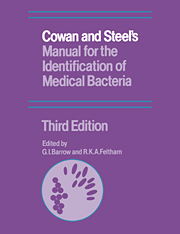Book contents
- Frontmatter
- Contents
- Foreword
- Preface to the first edition
- Postscript
- Preface to the second edition
- Preface to the third edition
- List of contributors
- Introduction
- 1 Classification and nomenclature
- 2 Culture media: constituents and sterilization
- 3 Principles of isolation
- 4 Bacterial characters and characterization
- 5 Theory and practice of bacterial identification
- 6 Characters of Gram-positive bacteria
- 7 Characters of Gram-negative bacteria
- 8 Taxonomy in theory and practice
- 9 Bacterial identification by cards
- 10 Bacterial identification by computer
- 11 Quality control in microbiology
- Appendices
- A Preparation and control of culture media
- B Staining: reagents and methods
- C Characterization tests
- D Test organisms
- E Preparation and use of Identicards
- F Use of computers
- G The Bacteriological Code
- H The Approved Lists of Bacterial Names
- I Reconciliation of Approaches to Bacterial Systematics
- J Glossary
- References
- Index
B - Staining: reagents and methods
Published online by Cambridge University Press: 15 December 2009
- Frontmatter
- Contents
- Foreword
- Preface to the first edition
- Postscript
- Preface to the second edition
- Preface to the third edition
- List of contributors
- Introduction
- 1 Classification and nomenclature
- 2 Culture media: constituents and sterilization
- 3 Principles of isolation
- 4 Bacterial characters and characterization
- 5 Theory and practice of bacterial identification
- 6 Characters of Gram-positive bacteria
- 7 Characters of Gram-negative bacteria
- 8 Taxonomy in theory and practice
- 9 Bacterial identification by cards
- 10 Bacterial identification by computer
- 11 Quality control in microbiology
- Appendices
- A Preparation and control of culture media
- B Staining: reagents and methods
- C Characterization tests
- D Test organisms
- E Preparation and use of Identicards
- F Use of computers
- G The Bacteriological Code
- H The Approved Lists of Bacterial Names
- I Reconciliation of Approaches to Bacterial Systematics
- J Glossary
- References
- Index
Summary
REAGENTS
All staining reagents should be kept in well-closed glassstoppered bottles (except Loeffler's methylene blue) and protected from direct sunlight. For frequent use, flexible plastic bottles with tube outlets may be used but they must be washed out thoroughly before refilling. They should not be stored in close proximity to concentrated acids or ammonia. Distilled water for reagents should be freshly prepared and neutral in reaction.
Formulae of staining reagents are listed in alphabetical order.
Acetone – iodine solution for decolorization
Strong iodine solution
Dissolve the iodine and potassium iodide in the water and adjust to volume with the ethanol.
Mix well before use
Acid-alcohol
Mix well before use.
Albert's stain
Dissolve the dyes in the ethanol. Mix the acid with the water and add to the dye solution. Allow to stand for 24 h and then filter.
Ammoniacal silver nitrate solution
Dissolve the nitrate in the water; to 90 ml of this solution add strong ammonia solution (sp. gr. 0.880) drop by drop until the precipitate which forms just dissolves; add sufficient of the remaining AgNO3 solution drop by drop until the reagent remains faintly turbid even after shaking. When protected from light, this reagent is stable for several weeks.
Ammonium oxalate – crystal violet stain
Mix and dissolve.
For use, mix 20 ml of solution A and 80 ml of solution B.
Aqueous solutions
Simple aqueous solutions of each of the following are used in staining.
- Type
- Chapter
- Information
- Publisher: Cambridge University PressPrint publication year: 1993
- 1
- Cited by



